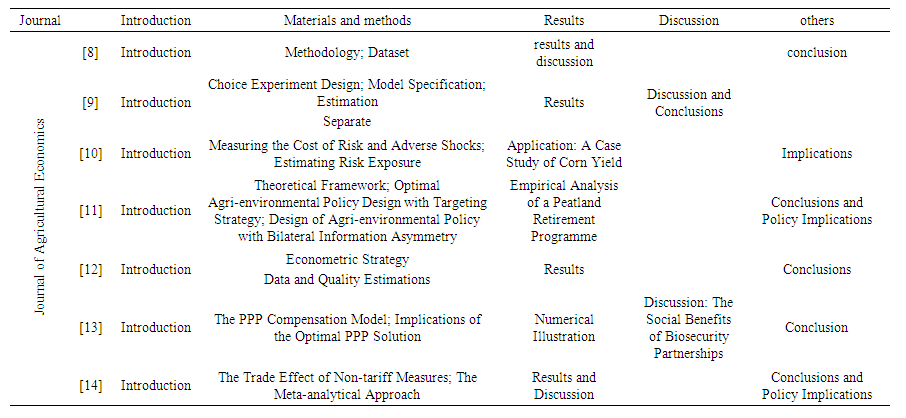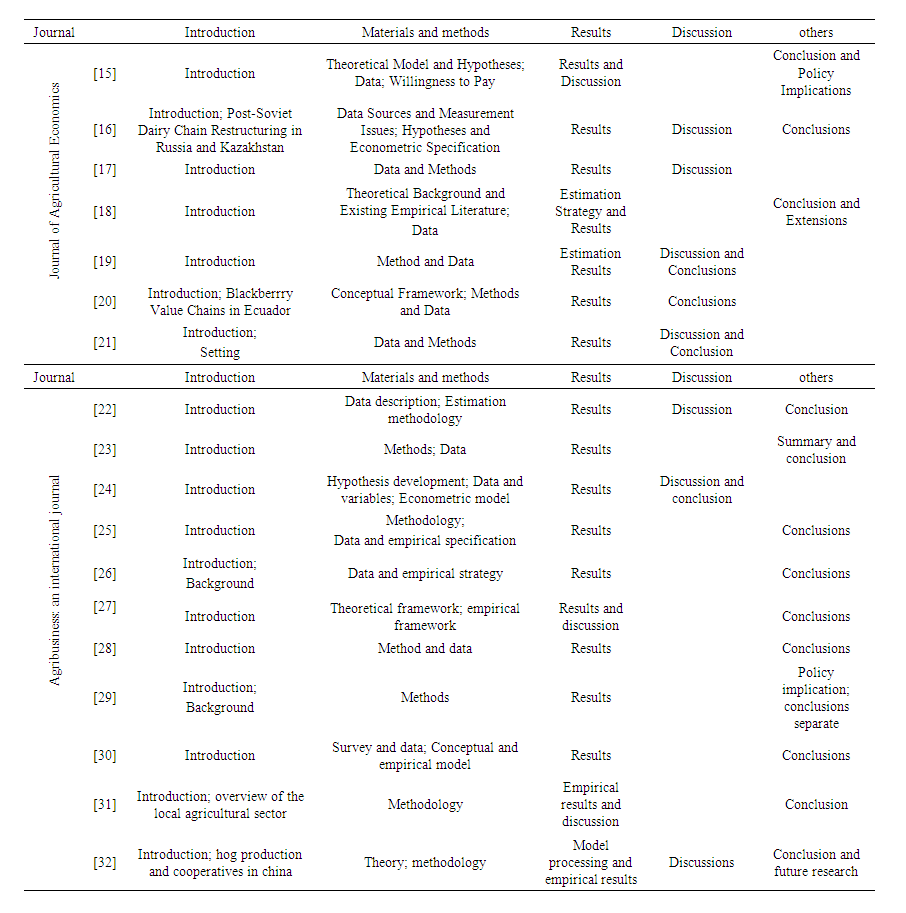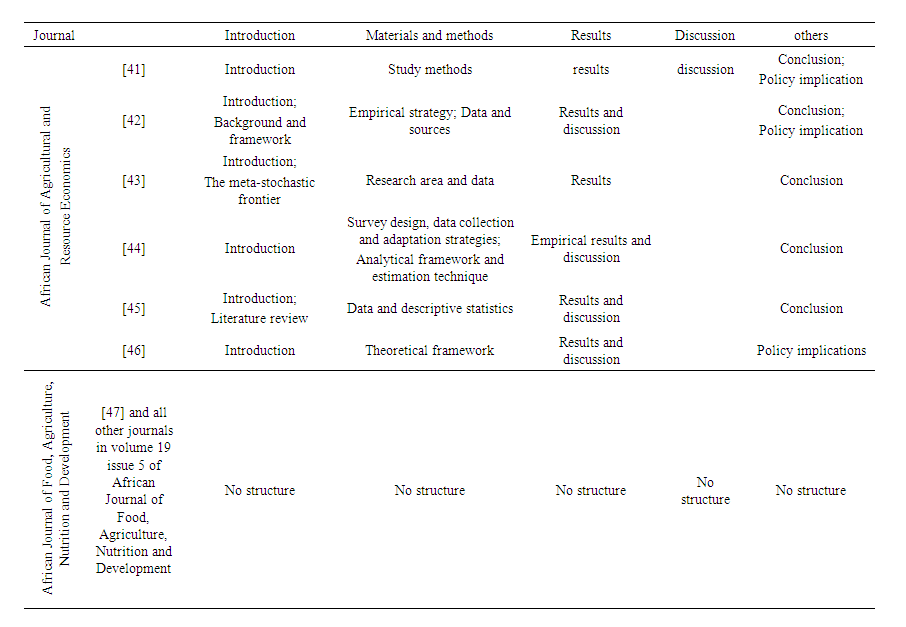-
Paper Information
- Paper Submission
-
Journal Information
- About This Journal
- Editorial Board
- Current Issue
- Archive
- Author Guidelines
- Contact Us
International Journal of Information Science
p-ISSN: 2163-1921 e-ISSN: 2163-193X
2020; 10(1): 9-14
doi:10.5923/j.ijis.20201001.02

Scientific Paper Structure for Agricultural Economists
Jacqueline Baidoo
Department of Agriculture Economics and Agribusiness, School of Basic and Applied Sciences, University for Ghana, Legon, Accra, Ghana
Correspondence to: Jacqueline Baidoo, Department of Agriculture Economics and Agribusiness, School of Basic and Applied Sciences, University for Ghana, Legon, Accra, Ghana.
| Email: |  |
Copyright © 2020 The Author(s). Published by Scientific & Academic Publishing.
This work is licensed under the Creative Commons Attribution International License (CC BY).
http://creativecommons.org/licenses/by/4.0/

The introduction; materials and methods; results and discussion (IMRAD) structure makes it easy for one to present his research findings. Is this structure applicable for agriculture economics and agribusiness scientists? This question was answered using 5 journals from SCOPUS. IMRAD structure is good since it helps the reader to follow the sequence of a paper. The IMRAD structure should be IMRADC to include the conclusion since conclusion summarizes the findings and discussions and also make recommendations. Agricultural economics journals should stick to the IMRADC structure.
Keywords: IMRAD, Agriculture economics, Scientific paper structure, Paper writing
Cite this paper: Jacqueline Baidoo, Scientific Paper Structure for Agricultural Economists, International Journal of Information Science, Vol. 10 No. 1, 2020, pp. 9-14. doi: 10.5923/j.ijis.20201001.02.
1. Introduction
- The introduction; materials and methods; results and discussion (IMRAD) structure was adapted in 1970 and from 1972, it was a requirement by editors [1]. This structure since then is widely accepted in scientific writing. The IMRAD structure provides a skeleton for structuring a research paper [2]. This structure makes it easy for one to present his research findings [2]. There has however, been challenges with the IMRAD structure regarding which information to put on each structure [3]. This has brought an improvement in the IMRAD structure. Other journals use IRDAM, [4] IMRADC and IMRADAC.The IMRAD structure does not fit economics and sociology [5]. Agriculture and other related studies now include conclusion and recommendation in their write ups. This is because applied scientist uses already known theory to provide answer to questions. The IMRAD structure is not able to properly fit into agriculture researches [6]. Agriculture papers are sub titled differently making it difficult for readers to know the part of the IMRAD structure they are reading. There has currently been no study to find out if agriculture peer reviewed journals are using the IMRAD structure. The IMRAD structure is not a straight jacket since it is silent on crucial components of a modern research paper [3]. It has plenty of room for creativity and innovation. Is the IMRAD structure applicable for agriculture economics and agribusiness scientist? The question was answered by reviewing papers in recent issues of journals published. This study on the IMRAD structure would help agricultural economist scientist follow a set of pattern for writing papers.
2. Methods
- The research question was answered by finding out from agriculture economics and agribusiness colleagues at the University of Ghana the journals they publish in. Fifteen journals were identified. A follow up was made on the internet by cross checking if they are SCOPUS journals. Publications that was not on SCOPUS were rejected. The following journals mentioned by colleagues were in SCOPUS database; Journal of Agricultural Economics, Agribusiness: an international journal, African journal for rural development, African Journal of Agricultural and Resource Economics and African Journal of Food, Agriculture, Nutrition and Development (Table 1). Journal volumes published in 2019/2020 were selected. A journal issue on the webpage of the selected journals was randomly selected as seen on the website. The following issues as shown below were selected. Journal of Agricultural Economics issue 3Agribusiness: an international journal issue 1African journal for rural development issue 1African Journal of Agricultural and Resource Economics issue 4African Journal of Food, Agriculture, Nutrition and Development issue 5Each paper in the journal was checked to see if it followed the IMRAD structure (Table 1). There were sections for introduction, materials and methods, results, discussion and others as specified by the authors. Sections that implied any of the IMRAD structure and not stated explicitly was grouped under the IMRAD structure it implied (Table 1).
3. Results
- All journals except African journal of Food, Agriculture, nutrition and Development has introduction explicitly specified. Food, Agriculture, nutrition and Development has a continuous text format of structure in its presentation so does not follow the IMRAD structure. About 4 out of 39 journals had background and introduction of specific topics as titles aside introduction (Table 1). Background and hypothesis are some issues addressed under hypothesis [5]. Introduction is widely used in headings.No study addressed materials as a section. This might be because agriculture economics does not use materials. Survey is mostly used in collecting data, and rigorous economic methods/tools used for analysis More than half (23 out of 49) of the papers used data, methods and methodology as topics under materials and methods (Table 1). About half (21 out of 49) used results separately (Table 1). One third (14 out of 49) papers compared results and discussion in one section. Discussion section does not appear in most papers. About 31 out of 49 papers does not have a section on discussion (Table 1). It appears that discussion is either combined with results or conclusion. This confirms the challenge with the IMRAD structure regarding which information to put on each structure [3]. Three studies combined discussion and conclusion in one section and one study used conclusion in place of discussion. All journals except African Journal of Food, Agriculture, nutrition and Development had other sections like conclusion and policy implication (Table 1). This shows the significance of conclusion and recommendation in agriculture studies.
 | Table 1. IMRAD Structure Outlined in the Journal |
 | Table 1. Continued: IMRAD Structure Outlined in the Journal |
 | Table 1. Continued: IMRAD Structure Outlined in the Journal |
 | Table 1. Continued: IMRAD Structure Outlined in the Journal |
4. Discussion
- All the journals selected except African Journal of Food, Agriculture, nutrition and Development are using the IMRAD structure (Table 1).Journal of Agricultural EconomicsThe objective of this journal is to study and apply agriculture economics to agriculture, food and related issues. Economics, statistics, marketing, business management, politics, history and sociology are the disciplines of this journal. This journal does not have materials in its structures; methodology is used instead. This might be because it concentrates on applied science which does less experiments. In the paper sampled on this journal, [8] structure was introduction, methodology, dataset, results and discussion and conclusion. Methodology concentrated on the conceptual framework while dataset look at the sampling techniques. Conclusion summaries results and discussion after which recommendations were made. Less is dealt on the discussion (Table 1) but conclusion and implication of the study is very important to authors. Since it is economic in nature there are much sections under methodology. This finding confirm that IMRAD structure does not fit economics [5].Agribusiness: an international journalThis journal accepts papers that uses economic analysis to improves our understanding of how food systems work, how they are evolving, and how public and/or private actions affect the performance of the global agro-industrial complex. This journal for the year 2020 follows the IMRAD structure even though some titles are named differently (Table 1). This confirms the findings that the IMRAD structure provides a skeleton for structuring a research paper [2]. [22] called the methodology and materials data description, estimated methodology and methods. This might be because data and methods fits well for agriculture scientist. Conclusion was addressed separately in the papers. Since this journal delve mostly on economic analysis, it is of no doubt why most papers has different headlines all under materials and methods.African journal for rural developmentThis journal publishes papers of emerging issues in rural development, sustainable development of rural communities and improving livelihoods. This journal follows the IMRAD structure. [33] used methodology instead of materials and methods. [34] used research approach instead of methodology. All papers combined results and discussion as one section. Conclusion were present in all papers. Three out of five papers included conclusion and recommendation as one section (Table 1). Naming of sections were left to authors themselves instead of defined IMRAD structure to be followed. This confirms to findings that the IMRAD structure is not a straight jacket since it is silent on crucial components of a modern research paper [3].African Journal of Agricultural and Resource EconomicsThe journal accepts papers that addresses how African agriculture interacts with local and global economic systems and policy regimes in its impacts upon people. From volume 14 issue 4 of the journal released, journal followed the IMRAD structure even though authors named sections differently as shown in Table 1. The journal is economics biased as authors spend more time explaining models either in the introduction or the methods. Authors pay particular attention to policy implication since it is the requirement of the journal ([45]; [40]; [41]). This is the gap in the IMRAD structure. Results and discussion cannot compensate for conclusion and policy implication.African Journal of Food, Agriculture, Nutrition and DevelopmentThe African Journal of Food, Agriculture, Nutrition and Development (AJFAND) is concerned about dissemination and sharing of food and nutrition information issues on the continent. This journal does not explicitly state the IMRAD structure. The structure is however implied in the work. Readers are able to identify sections of the IMRAD structure as they read along. The major challenge is that readers cannot read only a section of the journal to understand. This confirms findings that the IMRAD structure makes it easy for one to present his research findings [2].
5. Conclusions
- IMRAD structure is good since it helps the reader to follow the sequence of a paper. IMRAD is an acronym for introduction, methodology, results and discussion. Conclusion, which is part of the structure of all study is omitted. The IMRAD structure should be IMRADC to include the conclusion since conclusion summarizes the findings and discussions and also make recommendations. Agricultural economics journals should stick to the IMRADC structure.
ACKNOWLEDGEMENTS
- I am grateful to Professor Sarpong for inspiring me to conduct this research.
 Abstract
Abstract Reference
Reference Full-Text PDF
Full-Text PDF Full-text HTML
Full-text HTML